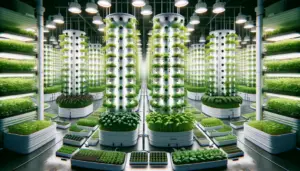
Forget everything you thought you knew about gardening! Imagine harvesting a whole salad’s worth of lettuce or a handful of fragrant basil without ever touching a bag of soil. Sound impossible? It’s called aeroponics, and it’s way cooler than regular gardening.
Think of aeroponics like your green-thumb goals mixed with a bit of a science experiment. Instead of planting in the ground, your plants get to hang out with their roots dangling in thin air. They’re constantly pampered with a supercharged, nutrient-rich mist – it’s like a plant spa day!
Ready to ditch the weeding, fight off less pests, and maybe even grow plants faster than ever? Buckle up, because we’re about to dive into the world of aeroponics. We’ll explain how it works, what you can grow, and how to get started on this totally awesome way of gardening.
How Aeroponic Systems Work
Forget complicated diagrams – understanding how aeroponics works is surprisingly simple! Here’s the basic setup:
- The Root Zone: Picture a cozy, dark chamber where your plant roots get to hang out – think of it like their super-chill hangout spot. Remember, roots thrive in the dark, and any sneaky light can cause problems (like algae growth).
- The Power Source: Beneath this chamber, you’ll find a reservoir. It’s like a storage tank for water that’s been mixed with a special plant superfood – hydroponic fertilizer. A pump in the reservoir does all the heavy lifting.
- Misting Magic: The pump sends the nutrient-rich water up to special nozzles. These nozzles transform the water into a super-fine mist, spraying it directly onto those happy roots. Think of it like a refreshing spa mist for plants, 24/7.
Why All the Fuss About Mist?
- Supercharged Growth: The tiny water droplets in the mist make it incredibly easy for roots to soak up all the water and nutrients they need to thrive.
- Oxygen Boost: Unlike in soil, where roots can get compacted, the roots in an aeroponic system get tons of oxygen. It’s like a breath of fresh air that helps them grow faster and healthier.
Benefits of Aeroponic Systems
Aeroponics isn’t just about growing plants in a cool way. It also comes with some seriously amazing perks:
- Speed Champions: Get ready to harvest way faster! Many plants grow significantly faster in an aeroponic system compared to traditional soil gardening.
- Water Warriors: Say goodbye to drought worries. Aeroponic systems conserve a ton of water by recycling it within the system.
- Space Savers Ditch the massive garden plot! Aeroponics lets you grow vertically, make use of small corners, or get creative with how you arrange your plants.
- Clean and Green: Forget battling soil-borne pests or messy weeds. Aeroponics offers a cleaner, more controlled growing environment.
It’s Not Just About the Hype
We get it; it might sound a little too good to be true. But the benefits of aeroponics are real and make it an awesome option for all sorts of growers, from beginners to those wanting to maximize their harvests.
What Can You Grow in an Aeroponic System
While a huge variety of plants can be grown aeroponically, if you’re starting out, it’s best to choose ones that are practically foolproof:
- Leafy Greens Galore: Think salads and stir-fries! Lettuce, spinach, kale, arugula, Swiss chard… these fast growers absolutely love the constant nutrient boost they get from aeroponics.
- Herb Heaven: Snip fresh basil, mint, chives, parsley, and more for every single meal. Your dishes will never be the same!
- Fruiting Veggies (with a Caveat): If you have plenty of light, compact varieties of tomatoes, peppers, strawberries, and even cucumbers can do well. Just know you might need to provide a little extra support as they grow.
Factors to Keep in Mind
- Size Matters: Stick with plants that have relatively compact root systems, especially for smaller setups. Massive root vegetables might be a challenge!
- Light Lovers: Relying on natural light? Choose plants that match your available light conditions. If you plan to use grow lights, it opens up even more possibilities.
- Support Needs: Taller plants, like tomatoes, or vining varieties might need some simple trellising or stakes to keep them from toppling over.
The More You Grow, the More You Know
Once you get comfortable, you can start experimenting! With the right setup and knowledge, there are tons of other vegetables, fruits, and even flowers that grow beautifully in aeroponic systems.
Getting Started with Aeroponics
The good news is there’s an aeroponic path for everyone, whether you’re handy or prefer a more plug-and-play approach. Here’s the breakdown:
Option 1: The DIY Route
- Perfect for: Folks who enjoy a project, like to tinker, and potentially want to save some money.
- The Gist: You’ll gather the components yourself (reservoir, pump, nozzles, growing chamber, etc.) and assemble your system.
- Resources are Key: There are TONS of plans and tutorials online, ranging from super-simple bucket-based builds to more elaborate designs.
Option 2: Pre-Made Kits
- Perfect for: Those who want to jump in quickly with minimal fuss, or who are unsure about the DIY process.
- The Gist: Kits come with all the major components you need. You do the assembly (which is usually pretty straightforward), add your water and nutrients, and pop in your plants.
- A Range of Options: You’ll find kits of varying sizes, complexity levels, and price points to suit your needs and budget.
- We recommend the Nutraponic System which you can find here.
Don’t Be Afraid to Start Small
Even a tiny herb garden is a fantastic way to try out aeroponics and see if you love it! As you (and your plant collection) grow more confident, you can always expand your system or try a more elaborate design
Where to Go From Here
Whether you’re buying a kit or gathering supplies, your next step will involve more specific choices. In a future article or guide, consider helping readers with things like:
- Plant Selection: Matching the perfect plants to their system and available light.
- Hydroponic Nutrients: Understanding fertilizers designed for soilless systems.
- Maximizing Grow Space: Tips on vertical growing and creative system designs.
Conclusion
From space-saving potential to faster harvests and the sheer joy of futuristic gardening, aeroponics opens up a whole new world of growing possibilities. Sure, there’s always more to learn, but even the most experienced aeroponic growers started with their first simple setup. Embrace the journey, experiment, and celebrate the incredible power of growing plants with air!
FAQs: Your Aeroponics Questions Answered
Is aeroponics really better than soil gardening?
- It depends on your goals! Aeroponics often leads to faster growth, water savings, and fewer pests. However, soil gardening can be less technical and more forgiving for beginners.
Is aeroponics expensive?
- The initial setup cost might be higher than a basic soil garden. However, aeroponics saves money in the long run due to reduced water use and potentially faster, more plentiful harvests.
Is it difficult to get started with aeroponics?
- Not at all! Pre-made kits make it incredibly simple to get started, while numerous online resources exist for DIY enthusiasts.
Do I need a lot of special equipment?
- The basics include a reservoir, pump, misting nozzles, timer, and growing chamber. Kits often come with all these components included.
What about nutrients?
- Plants in aeroponics need specially formulated hydroponic nutrients designed for soilless growing.
Is it difficult to maintain an aeroponic system?
- Once established, maintenance is fairly simple. Regular tasks include checking water levels, misting function, testing and adjusting nutrients, and basic cleaning to prevent clogs.
What’s the most common mistake beginners make?
- Not ensuring the root zone is completely dark. Any light leaking into your chamber promotes algae growth, which can compete with your plants.
How often do I need to change the water?
- Ideally, test and adjust the nutrient solution weekly. For smaller home systems, a complete change every 2-3 weeks might be needed, depending on your plants.
Can I still grow plants organically in aeroponics?
- Yes! While hydroponic fertilizers are necessary, there are organic options available. However, obtaining organic certification for your produce often involves additional requirements.
Where can I find help and learn more about aeroponics?
- Online forums and communities dedicated to hydroponics and aeroponics
- Websites and blogs focused on home-scale setups
- Youtube tutorials and build demonstrations
